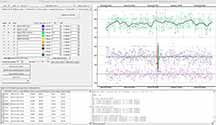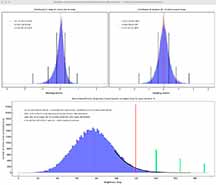

This is a high rank event by a named asteroid. The path goes across the SC Mtns, optimal places are Locatelli Meadow, and also Karl's place is near the centerline. It's in Orion, high in the sky. Alt=66, Az=148 in SSE. The duration is long, at 1.2s and so that will allow longer integrations to get this faint target. I may try this from Locatelli, as it's only 1hr 20 min before the brighter event by Pervictoralex at 2:05am which is best from around Twin Gates, but misses Karl.
 |
 |
All 3 of Karl, Kirk and I got recordings and Karl had an apparent ~1/2s positive while watching live, and I believed I did as well, of a little under a second. Kirk recorded at Gazos Creek and Hwy 1 just north of the centerline, and could not tell on the small camcorder monitor whether he had a positive or not.
I observed from the entrance to San Vicente Redwoods trail on Empire Grade. Skies were clear, calm, and cold. The target was high, and the sky was moonless and quite dark. Even at 16x, the sky pixels were clipped at the low end. Predicted drop was to W=~ 15.6, which is below the limiting magnitude, and the light curve is consistent with this drop.
Long: 122 09 19.13
Lat: 37 06 57.82
Elev: 901m
f
Event has only 1 chance in 20,000 of being due to random noise. It happens within 1 second of the predicted event time.
Below is the solution using TME apertures for all stars, and min/max event duration selections of 2 -> 15 points. The event was detected, giving...
magDrop report: percentDrop: 75.9 magDrop: 1.545 +/- 1.332 (0.95 ci)
DNR: 4.00
D time: [08:45:48.4633]
D: 0.6800 containment intervals: {+/- 0.0922} seconds
D: 0.9500 containment intervals: {+/- 0.2360} seconds
D: 0.9973 containment intervals: {+/- 0.5418} seconds
R time: [08:45:49.3098]
R: 0.6800 containment intervals: {+/- 0.0922} seconds
R: 0.9500 containment intervals: {+/- 0.2360} seconds
R: 0.9973 containment intervals: {+/- 0.5418} seconds
Duration (R - D): 0.8465 seconds
Duration: 0.6800 containment intervals: {+/- 0.1417} seconds
Duration: 0.9500 containment intervals: {+/- 0.3240} seconds
Duration: 0.9973 containment intervals: {+/- 0.6733} seconds
|
Solution, zoomed in |
Using the reference star, which maxed the target flatness at a surprisingly small smoothing interval, the False Positive test comes in at 4.0 sigma. |
By not using the reference star, False Positive test comes in slightly stronger at 4.1 sigma. |
However, I got a slightly better FP test result when I did not use the reference star to calibrate the target. There were no clouds, but there was scintillation, even at 16x, due to the likely convection to the cold night sky. The minimum for the metric interval happened at a rather small smoothing level as you see above, with still a rather saw-toothy look, and if not due to real correlated causation, then it may be adding noise in quadrature to the target light curve. It might be most accurate to use no reference star. However, the magnitude drop is slightly less and DNR slightly less as well. To my eye, the D is positioned more reasonably The solution given then was...
magDrop report: percentDrop: 74.9 magDrop: 1.503 +/- 1.291 (0.95 ci)
DNR: 3.95
D time: [08:45:48.4699]
D: 0.6800 containment intervals: {+/- 0.0936} seconds
D: 0.9500 containment intervals: {+/- 0.2365} seconds
D: 0.9973 containment intervals: {+/- 0.5245} seconds
R time: [08:45:49.3098]
R: 0.6800 containment intervals: {+/- 0.0936} seconds
R: 0.9500 containment intervals: {+/- 0.2365} seconds
R: 0.9973 containment intervals: {+/- 0.5245} seconds
Duration (R - D): 0.8399 seconds
Duration: 0.6800 containment intervals: {+/- 0.1456} seconds
Duration: 0.9500 containment intervals: {+/- 0.3306} seconds
Duration: 0.9973 containment intervals: {+/- 0.6861} seconds
IOTA report sent in 2/5/25
I got very noisy results on Moreau, 16x from Gazos Creek. I used TME apertures in PyMovie, and PyOTE found a 0.9246 sec. event near the predicted time using min/max, but it got less than 3 sigma on the NIE (false positive) test. There are several single integration deeper drops throughout, but there is a 3-integration drop of predicted 1 mag (but this is about the absolute limiting magnitude, so true depth could be greater) near the predicted time. I tried static and dynamic mask apertures, but still failed the NIE test. I got better results smoothing on a reference star than not smoothing. The detectability test said"An event of duration 1.350 seconds with magDrop: 1.0 is likely detectable." Predicted max was 1.17 sec, so it was on the edge of detectability. I first went to the turnout on the corner of hwy 1 and Gazos creek road, but there was some wind from the north, so I went to the gas station parking lot, and with trees to the north there was hardly any wind where I set up. But there was flickering and shimmering of the stars in the camera field, so the air above me was probably turbulent. In more stable air I probably would have got better results. I was near the centerline and you two got positives so I should have gotten a positive.
RN: I note that his event was early by about the same amount as my much clearer event was also early, so I believe Kirk's event was real and will plot on the sky plane consistently.
magDrop report: percentDrop: 63.6 magDrop: 1.098 +/- 0.170 (0.95 ci)
DNR: 2.45
D time: [08:45:50.0858]
D: 0.6800 containment intervals: {+/- 0.0662} seconds
D: 0.9500 containment intervals: {+/- 0.1829} seconds
D: 0.9973 containment intervals: {+/- 0.4107} seconds
R time: [08:45:51.0104]
R: 0.6800 containment intervals: {+/- 0.0662} seconds
R: 0.9500 containment intervals: {+/- 0.1829} seconds
R: 0.9973 containment intervals: {+/- 0.4107} seconds
Duration (R - D): 0.9246 seconds
Duration: 0.6800 containment intervals: {+/- 0.0956} seconds
Duration: 0.9500 containment intervals: {+/- 0.2272} seconds
Duration: 0.9973 containment intervals: {+/- 0.4499} seconds
 |
 |
 |
The event was early by about an asteroid diameter, the same as indicated at my site. |
 |
Got a recording from home. Is reducing it, and will also send the .avi to me and Kirk. Believes he had a clear positive, but short.